COVER- Fatal roll: 1982 fraternity crash still affecting lives
 The tension was rising in the cab of the lumbering U-Haul. "I was aware of the turn," said the driver. "I was cutting the wheel."
The tension was rising in the cab of the lumbering U-Haul. "I was aware of the turn," said the driver. "I was cutting the wheel."
Back in the cargo hold, spirits were high; and although some of the 64 passengers felt braking and downshifting, they had no way of knowing what was about to happen. Crowded into the windowless space, they sang and drank, ignorant of the drama unfolding up front, where their driver was fighting to maintain control of the overloaded truck on a sharp curve.
Suddenly, a flash of headlights in the opposite lane closed off the option of swinging wide. "I knew I had to stay in my lane," said the driver. "I had to hold on to my lane."
Just as the partying students in back were finishing a raucous song, the truck tipped up on its three left-side wheels, and the voices of merriment were silenced by the scrape of metal on pavement and the cries of shocked and injured men.
This is a story about a fraternity "roll" in a rented U-Haul truck, and an accident that changed lives– and ended lives. And it changed UVA, too. The infamous Sigma Chi fraternity wreck happened 25 years ago this week.
'A totally sound concept..'
October 6, 1982 was a warm fall day, and the young men were wending their way south– in a rented U-Haul truck– to party with women at Randolph-Macon Woman's College in Lynchburg.
Back in 1982, there was nothing unusual about this method of travel. As the fraternity president later told investigators, "The truck has traditionally been a high-energy situation. 'Festive' would be the best word– people singing, sweating, standing up, and drinking."
Inside the truck, the temperature was rising quickly, and the 64 passengers were drenched with sweat, their deodorant and aftershave powerless against the heat from so many bodies in an unventilated space. In an attempt to remain presentable for the party in Lynchburg, many had stripped off their oxford shirts.
Although initial media reports confused the issue, a "roll" was not necessarily a truck trip; it was the traditional UVA word for any voyage to a women's college. Coeducation had arrived at UVA a dozen years earlier, but for many fraternities, the "roll" remained a common practice.
If many of UVA's 30-some fraternities caravaned with cars, Sigma Chi was one of at least eight using trucks, according to a poll taken the following day by the Inter-Fraternity Council president. Even the Dean of Students, in an interview with federal investigators, admitted that truck rolls were a decades-old tradition– and pointed out that automobile rolls had caused several accidents with serious injuries and fatalities.
A rented truck usually cost less than $50 and could easily accommodate a sufficient crowd and enough beer for a trip to, say, Mary Baldwin, Sweet Briar, or Hollins.
"It seemed like a totally sound concept," says Mark Fenster. Today a law professor, but then a second-year Sigma Chi rushee, Fenster admits he understood the logic of the arrangement: "One vehicle, with one driver, instead of 15 cars traveling over the mountain and back– kind of brilliant, really."
Because they'd traveled this way before, fraternity officers knew what to expect for this Wednesday night roll to R-MWC, which lies just over the James River. The boys were headed to "The Pines," a cluster of former sorority houses rentable for on-campus parties. With porches and fireplaces, the rustic cottages overlooking the dell at "Randy Mac" were a desirable destination for such a low-key mid-week mixer.
For the recruits, or rushees, it was supposed to be an exciting adventure. In the hope of impressing the pledge class, Sigma Chi had scheduled it in the days leading up to Bid Night.
Taco night
The Sigma Chi house is located on Preston Place, just a few blocks from Rugby Road, the main fraternity drag. Besides beer and bands, each Sigma Chi brother's $45 monthly dues paid for dinners at the house, and tonight it was tacos, which disappeared quickly.
Around 6:30pm, several first-years from UVA's Lefevre dorm arrived. Some ate what was left of the taco dinner and mingled out front with the growing crowd enjoying the 70-degree weather and waiting to climb into the U-Haul, a 1974 Ford truck already parked in the driveway.
Second-year student David Jaffe hadn't thought the fraternity scene was right for him the previous fall, but this year he'd reconnected with some friends from his high school in Arlington, and so he found himself rushing.
He got to the house just as the dinner was finishing up and met up with one of those buddies, Christopher Meigs. A mathematics honor student and four-year veteran of the football team at Jaffe's high school, Meigs had also chosen this night to go on his first roll.
As the group stood in the yard at Sigma Chi, they recounted an "amazing, sliding, diving catch" Meigs had made earlier that day in a touch football game. It would be his last.
The ideal of Animal House
In the early 1980s, UVA's nearly 40 social fraternities drew approximately half of the school's undergraduate men, according to the 1982-83 edition of the Selective Guide to Colleges, and the organizations were routinely described as self-regulating by university administrators.
"It was rare that parties got busted," says former Sigma Chi Fenster today. "Everything was just looser as far as drinking and partying."
Fenster says almost all parties were open, including popular "grain parties," where inebriation was only a cup of 194-proof punch away. And just beneath the mainstream surface of UVA's alcohol culture, Fenster also remembers pervasive hard-drug use. He says that Ecstasy, which was not federally outlawed until 1985, "hit UVA hard and early," even before it ripped though the northeastern schools nearer his native New York City.
"There were also some 'shrooms, and a lot of marijuana and cocaine," Fenster says. But cheap domestic beer remained the intoxicant of choice, especially after 1974, when Virginia, like many states, followed the 26th Amendment, which lowered the voting age to 18, and dropped the state's legal beer-drinking age to match.
And then there was a certain now-classic movie, released just four years before that fateful October.
"Animal House was definitely held as an ideal of fraternity life," says Fenster. But unlike some other Rugby Road fraternities whose Southern traditions including drinking to oblivion, Sigma Chi had a milder reputation.
There were athletes and scholars and student leaders among the party boys– and even some religious and geographic diversity. Fenster, who describes himself as a "secular Jew from the northeast," was impressed.
'A perfectly pleasant party'
A keg-equipped advance team of several cars had already left for Lynchburg to set up the mixer by the time the U-Haul was revving in the Sigma Chi driveway.
The university offered an alternative in the form of buses– $40 an hour, including a driver. But Sigma Chi was not a wealthy fraternity, the chapter president would later tell investigators. And besides that, he said, UVA buses didn't allow alcohol.
Darkness had already fallen over Charlottesville as the 64 brothers and rushees climbed into the 24-foot cargo hold for the nearly 70-mile journey. They pulled out at 8:07pm, according to the young man who'd eventually go on trial for the accident.
Photographs taken later show a placard glued to the dashboard: "NO PASSENGERS ALLOWED IN REAR." In case that wasn't clear, there were more words: "PASSENGERS IN REAR AREA (CARGO AREA) RISK INJURY DUE TO SHIFTING CARGO, IMPACT EJECTION, AND LACK OF COLLISION PROTECTION."
In back with the passengers were three 32-gallon trash cans– one for shirts, one filled with ice for the 12 cases of Budweiser, and one for empties. An old sofa had been placed against the front bulkhead.
With the rolling party room measuring 7-by-20 feet, each passenger had less than 2.4 square feet of space, and six men opted to sit in the overhead "cab-over" compartment. Most of the rest had to stand– even on the four picnic benches lining the walls.
Investigators would later talk about an elevated center of gravity.
The cargo limit of the truck was 6,500 pounds, something that should have been posted on the truck's door. However, 64 average men (168 pounds, according to the Centers for Disease Control) plus furniture and beer meant the vehicle was carrying over 11,000 pounds– double its rated limit.
Veterans from previous truck rolls knew the drill. Once the rolling door came down, the passengers had no easy way to re-open it, so when the air became insufferably hot and stale, they'd pound on the wall for a pull-over.
After the wreck, investigators found four blue cartridges filled with nitrous oxide. It's a chemical better known as laughing gas and used in dentists' offices, but by the 1980s it had become a popular party drug, although no one aboard the U-Haul admitted using it that night. The chatter became increasingly lively as the truck rolled south.
The Sigma Chi brothers wanted to be sure this roll would be an enjoyable experience for their rushees, who constituted about half the crowd, especially since it could make or break the decision to pledge. And so the house "magister" had spent several hours earlier that afternoon in Clemons Library, customizing rhymes to spotlight each of his fellow travelers and their various foibles. Before long, the cargo hold filled with the sounds of singing, laughing, and bawdy limericks.
"It was just full of fellowship and brotherhood," remembers one survivor, and Fenster agrees. "It was," he says, "a perfectly pleasant party."
'Everything just flipped on over'
Forty-five minutes into the trip, the two students in the cab heard the pounding of fists and correctly surmised that the guys in back could use some fresh air and– with most of the beer already gone– a little relief. Now clad only in their khakis and jeans, passengers eagerly tumbled out for a roadside stop. When Fenster climbed back in a few minutes later, he was dismayed that someone had nabbed his spot on the left, so he found another place to stand. The switch may have saved his life.
For the second leg of the trip, a new driver, David H. Holmes, of Smithtown, New York, took the wheel. A third-year student, Holmes was tapped to drive for his sterling reputation that included admission into UVA's prestigious McIntire School of Commerce, his mentoring role as a Resident Advisor, or RA, in Lefevre dorm, and his role as an investigator for the school's hallowed Honor Committee. Not to mention his penchant for avoiding heavy drinking.
Holmes later told investigators that while he'd driven a U-Haul previously, he found this truck harder to steer, certainly looser than his Toyota Celica. Forensic technicians later found nothing wrong with the steering.
Less than a mile from the James River, Holmes turned off the five-lane Lynchburg Bypass onto Route 29-Business. Also known as Amherst Highway, it's an older, narrower road that winds through Madison Heights, a hilly community of houses and scattered roadside businesses northeast of downtown Lynchburg. Unlike the Bypass, it's hemmed in by trees that deny drivers a view of approaching traffic.
It happened on the final curve as the road drops toward the James River basin.
Holmes later described riding the brakes to keep the truck's speed in control, and he soon found himself struggling just to stay in his lane.
In the opposite direction, 58-year-old Madison Heights resident Marcellus Liggon was on his way home from visiting a friend. The route was familiar from his daily commute to the Lynchburg Foundry, so he slowed his 1967 Volkswagen Beetle in anticipation of what he knew to be a sharp curve. Then he saw the truck.
Liggon did not return the Hook's calls for comment, but he offered a reporter his account in 1982. "The truck just got away from its driver," he said. "I didn't even have time to get frightened. I could see he was going to come over on me, but I couldn't do a thing."
According to reports, despite Holmes' effort to control his speed down the hill, the U-Haul was traveling as much as 10 miles per hour over the posted limit of 35.
At about 9:35pm, as the truck took the nearly 90-degree curve, the left front tire began slipping over the line. When passengers in the back shifted left to absorb the energy, physics took over. According to investigators, the U-Haul's rear end swung into the opposite lane as Holmes fought to control the tilting truck. It rode on the three left-side wheels before tipping over and sliding into Liggon's northbound lane.
The VW Bug crashed through the roof of the truck, and the two crumpled vehicles slid together down the highway, scoring nearly 100 feet of pavement before coming to rest at Early Drive.
In her home, 75-year-old Pearl Coleman heard something "like an explosion" and telephoned for help, while her son, a rescue squad member, raced from her house to the scene.
Inside the truck, metal against metal sounded like an enormous can being wrenched open. Knife-sharp sheets of aluminum and plywood– along with the VW's front bumper– protruded into the cargo hold.
Nobody was really sure
"Everything seemed so fast," says Arlington native Jaffe. "At first, I thought it was just a really hard parking job." He had not yet grasped that a bench had just broken his cheek bone and two ribs.
The two drivers climbed out of the cab's passenger window and rushed around back to wrench open the door, but they found that it would open only about 20 inches. Jaffe squeezed out, took a few steps, and turned back towards the truck. Adrenaline surged as he saw the Volkswagen embedded in the roof, and he suddenly understood what had happened.
It was a clear night, and the moon, four days past full, cast an eerie light over the scene. A nearby billboard urged voters to re-elect Delegate Vance Wilkins. When the first passing car stopped to assist, the wheels of the truck were still spinning.
"There were a lot of guys just down, in the road and in the truck," says Jaffe, who recalls clusters forming on the pavement around the most seriously injured.
Jaffe wanted to help his high school friend Chris Meigs, who lay semi-conscious with severe trauma to his head and face. When he realized how badly Meigs was hurt, Jaffe returned to helping pull the others, some of whom were too shaken or injured to get themselves through the truck's narrow opening.
"Once we got everyone out into the light," Jaffe says, "you could see that some people were seriously hurt, and there was a lot of yelling."
Bob Jahrsdoerfer, a second year rushee, was unconscious in the truck with a severe head injury and blood gushing from where metal had punctured his skull over his eye. Another brother held his head up trying to keep his airway clear.
Thanks to quick calls by Pearl Coleman and her son, rescue vehicles from three surrounding counties began arriving within five minutes. Emergency units lined both sides of the now-blocked highway, illuminating the wreckage of strewn bodies and beer cans in a blur of flashing lights.
The most critically injured were soon on their way to Lynchburg General Hospital. When the ambulances were full, state troopers and some Sigma Chi brothers who'd been following the U-Haul in cars transported the less seriously injured.
But one passenger did not need transport. Brian Harold McKittrick of Oakton, one of the friends from Lefevre dorm, was lying motionless on a stretcher. Friends of driver Dave Holmes say he held his injured advisee and tried to comfort him until medical workers confirmed what he and the others had already sensed. The 17-year-old, who had arrived at UVA less than six weeks earlier, had died.
Holmes, seated in the front seat of a patrol car, covered his head in his arms and cried, periodically looking out at the horrific scene. A state trooper produced a hand-held Alco Sensor breathalyzer, and Holmes voluntarily took the test. He admitted he'd had a bourbon and Coke at Commerce School party and a beer in the cab.
A 3am call
As soon as they heard the crash, administrators at Lynchburg General went into disaster mode, calling in 15 off-duty doctors, about 50 support staff, and holding over the second shift. The first victim arrived at 10pm, and over the next 90 minutes, all 66 people aboard the U-Haul were ushered into the ER, 16 in critical or serious condition, including the athletic Meigs and at least five others who required immediate surgery. Liggon, the driver of the VW, was also admitted in serious condition.
The hospital was so overwhelmed that many parents were not called until much later. By the time the phone rang in one Northern Virginia family's home, it was 3am, and the caller was neither doctor, police, nor a UVA official. It was their son's girlfriend's roommate.
Tom Stumm, a popular fourth-year majoring in civil engineering and who had considered graduate school, was the person who had taken Fenster's spot after the pit-stop.
"We found out he was in critical condition," says Gloria Stumm. "By the time we got there, they had already operated."
Among Stumm's injuries was a broken shoulder, but far more ominous was a depressed skull fracture that had pushed bone fragments into his brain.
"The neurosurgeon," she recalls, "said it would be about 72 hours before we knew whether he was going to make it."
Getting back
At Randolph-Macon Woman's College, officials had opened the infirmary to anyone who needed a bed, but Meigs' friend Jaffe remembers just wanting to get back to Charlottesville. He called his roommate to pick him up.
Back at the Sigma Chi house, the father of the fraternity president had already arrived from his D.C.-area home to answer phone calls from frantic parents and girlfriends when the first wave of survivors began arriving around 2am.
One neighbor offered rooms to parents, and another fraternity had already come over to Sigma Chi to clean up the remains of the taco dinner, abandoned in the haste of getting on the road.
As the less seriously injured men arrived, the bleak reality sank in: life at Sigma Chi would never be the same. Besides the pall over the upcoming Bid Night, there were graver concerns.
Late Friday morning, less than two days after the accident, 18-year-old Chris Meigs died of injuries to his head, chest, and torso. And more than a month later, when most UVA students went home for Thanksgiving break, Tom Stumm and another student were still comatose.
Our prayers
As word rippled across the grounds, the University community continued to reach out. Girlfriends kept the house filled with flowers and home-baked cookies, and Beta Bridge was quickly painted with the words, "Our prayers are with you, Sigma Chi." (Until the 2007 massacre at Virginia Tech, the message held the record as longest-lasting at the ever-changing bridge.)
A moment of silence was observed at that Saturday's homecoming football game against Clemson. The following week, 750 students– several with swollen faces, casts, and limps– packed into St. Paul's Memorial Church to remember Meigs and McKittrick. A drawing of Istanbul's landmark Hagia Sophia by Meigs, an architecture student, adorned the program.
Fenster, who suffered two separate compound fractures, believes that if such a tragedy occurred today, it would prompt an even-wider public response with, he imagines, a campus-wide candlelight vigil, memorial ribbons, and, of course, Facebook groups.
"It's almost like now, in the wake of tragedies, everyone is expected to feel like they, personally, were touched by it," he says. "But then, we were left to process the accident in a much more private way."
Indeed, there's only a passing reference to the accident in the 1983 UVA annual, Corks & Curls. On the yearbook's page for Sigma Chi, there's no mention at all.
Brad Marwitz was one of the first-year students from Lefevre dorm, where the accident really hit home. He would learn of the deaths only when a police officer approached his hospital bed and asked if he "had" known McKittrick.
After two weeks in the hospital with a broken arm and internal injuries, Marwitz returned to school where, he recalls, "The accident was no longer a topic of much discussion."
McKittrick's absence, and Marwitz's own presence, noticeably discomfited his hallmates, especially the RA, Dave Holmes.
"I knew that he was suffering every time he saw me with my cast and cane," says Marwitz, "like he was re-living the accident."
Fenster, too, also remembers how guilt and anguish caused the brothers to feel that they had, even if unintentionally, pressured the recruits to go on that roll. Around the Sigma Chi house, he says, there was "a certain sense of shame."
'Not the life he'd planned'
Tom Stumm's mother kept vigil over him for the 10 weeks he remained in a coma at Lynchburg General. "He came out very gradually, not like on TV shows," Gloria Stumm recalls today. Even when he seemed to have fully awakened, he wasn't the person he'd been.
"He didn't try to speak for six months," she says. The family worked out a system by which Stumm, who could initially move only his right foot, would tap out letters on a board.
"Well, what if it does take two or three years out of his life?" Gloria Stumm remembers thinking. "He can still go back to college."
But after five more months in hospitals and five years of intensive physical, speech, and occupational therapy, the devastating reality had sunk in.
"Maybe it's good," she says, "if right at the beginning you don't know it's going to be a lifelong thing."
Now 46 and living near his parents in Richmond, Stumm remains disabled by speech and motor difficulties in addition to suffering lapses in short-term memory, not to mention brain injury-induced diabetes.
Although he eventually found work as a clerk with a civilian defense agency, he retired, his mother says, because work added too much stress to the rigors of day-to-day living. "It takes him twice as long," she says, "as it would take someone else to do things."
Stumm can now drive short distances, and two years ago, his parents got him a service dog which enables him to walk without a cane. He volunteers for Meals on Wheels, at church, and takes yoga classes two times a week.
While his UVA friends rallied for him in the aftermath of the accident, they gradually drifted away, and his mother says isolation is another unforeseen source of sadness.
"Who calls and says, 'Do you want to go to a movie tonight?'" she asks. "Nobody– that's the hardest."
Reached by telephone at his Richmond apartment, Stumm himself strikes an understanding tone about his friends. "They got more involved with their families," he says. "I wouldn't want to interfere with that."
The end of Easters
On November 4, 1982– nearly a month after the wreck– UVA's Dean of Students Robert Canevari officially recommended banning Easters, UVA's most notorious party weekend, a tradition that dated back to 1898. While Canevari insisted that the Sigma Chi accident was not the catalyst, the timing seemed clear enough to many on grounds– and off.
Charlottesville police chief John deK. Bowen suggested in the Daily Progress that the wreck had "prompted the unexpected move." But Bowen, whose force had begun raiding Rugby Road parties with 230 summonses that fall, had long pushed for an end to Easters' excesses.
Dean Canevari, now retired, declined comment on the accident or aftermath. Perhaps he's still feeling some chagrin from being known, as one satirical poster of the day branded him– à la the Grinch– as "The Dean Who Stole Easters."
"I doubt it was the sole cause," says UVA's current Dean of Fraternity and Sorority Life, Aaron Laushway, who was a UVA graduate student back then. "Clearly," he adds, the accident "increased the conversation about ways in which our students socialize and the responsibility placed upon their shoulders."
Virginia legal precedent had long absolved state universities of blame for students' actions, but three months before the accident, Virginia's new Tort Claims Act took effect to end such "sovereign immunity."
And Laushway recalls an advertisement Dean Canevari placed in the Cavalier Daily sometime before the last Easters urging students to rein in the event, which by that time had become an attraction for students and others from all over the East Coast.
Indeed, the University had been angling against Easters since at least since 1976, when a record 15,000 drug- and drink-fueled revelers descended on Rugby Road for what turned into a muddy bacchanal. "It wasn't Woodstock," says historian Coy Barefoot, "but it was the next best thing."
By 1982, Easters had been exiled to Lambeth Field, where 350 kegs were still mustered for the party faithful. But bad news kept coming. Two weeks before the truck accident, four students– three from VMI and one from R-MWC– had been killed in a car wreck. And 10 days after the truck accident, a UVA student was severely injured when he fell off a balcony at a grain party.
Things were happening on a national level, too. Ronald Reagan had been elected in a landslide of fiscal and social conservatism. Shortly after taking office in 1981, he followed the urging of an emerging group called Mothers Against Drunk Driving and created a special commission on drinking and driving.
In 1982, despite concerns that he was increasing federal power, Reagan began tying federal highway funding to state efforts to combat drunk driving. And two years later, Reagan signed the National Uniform Minimum Drinking Age Act, forcing all states to set their drinking age at 21– or lose highway funds. Although MADD's founder would quit over the group's turn toward "neo-prohibitionism," the era of easy drinking was ending.
Passenger fatigue?
Two months after the crash, David Holmes went on trial in an Amherst County court. The breath test administered at the scene showed that he tested at .08– right on the limit today, but legal under Virginia's .10 limit in effect at that time. He was convicted of misdemeanor improper driving and fined $50.
Now a banker in Richmond, Holmes declined comment for this article. The driver for the first leg of the ride, Dave Merrill, now a reporter for USA Today living in Northern Virginia, did not return the Hook's call.
Despite the fact that Holmes did not take a blood test and wasn't charged with driving under the influence, the National Transportation Safety Board, the NTSB, made the connection, announcing the following July that "an alcohol impaired driver and a disregard for safety" had caused the accident.
The NTSB called Holmes, who had been up studying most of the previous three nights, "sleep-deprived" in addition to noting his elevated (if not legally intoxicated) alcohol level.
Despite the pronouncement, survivors interviewed for this story scoff at driver blame. And, indeed, the NTSB suffered a PR fiasco upon release of its statement when its publicly bickering members decided to withhold their detailed report. (Much of the information for this story comes from the draft report the NTSB located at the Hook's request.)
If the Board's brief statement portrayed the accident as the result of an out-of-control drinking culture, it said little about passenger weight– double the truck's cargo maximum– or the shifting of the bodies. However, in an interview published by the Daily Progress six days after the accident, passenger Scott McDonald posited his own theory, which focused more on passenger fatigue than driver fatigue.
"We had been on the highway a long time," McDonald said, "and everybody was tired, extremely tired."
McDonald noted that the standing students had grown weary of bracing themselves by holding their hands to the ceiling. Moreover, stuck in the windowless space, they had no clue that their vehicle was about to encounter that tight curve in the James River basin.
"The driver is getting too much blame," said McDonald. "It was a natural shift of weight. Everybody hit the side, and it went over."
Fenster, the one who had initially considered truck rolls "brilliant," believes age and ignorance played a far greater role than alcohol. "Now, of course," he says, "it's so obviously and unbelievably stupid, to pile 60-some guys in the back of a truck like that. But at the time, it just seemed like a cool idea, a traveling party."
In an emergency session the day after the accident, the UVA Inter-Fraternity Council banned the use of non-passenger vehicles for off-grounds events.
'There is a life'
For most of the passengers on that fateful truck roll, the physical wounds have healed. Most contacted for this story have married; many have children. But none have forgotten that night. Even those who weren't on board.
First-year student Harry Frazier was asleep in his basement room in Lefevre when Holmes woke him and other sleeping advisees to personally break the news about McKittrick. "Brian's dead," Frazier remembers his RA saying, "and I was driving."
One of Holmes' fellow RAs, Cathy Harris Helms, now an elected district attorney in southern Georgia, says the emotional toll surpasses any punishment that could have been levied on Holmes.
"I think it profoundly affected him for a long, long time," says Helms, who accompanied Holmes to McKittrick's funeral in Northern Virginia. "That was very hard and very painful, but Dave did it. He felt it was important."
Helms remembers McKittrick, for whom she gave a eulogy, as "a good guy, tall, smart, very sweet-natured." Messages left at the Northern Virginia home of McKittrick's father, Harold McKittrick, were not returned.
None of those interviewed for this article knew how to reach the family of Christopher Meigs, nor did the alumni office of Arlington's Yorktown High School. His RA, Steve Braverman, now a doctor in Kentucky, says he recalls a well-liked, athletic, and friendly young man, but he had known him for only the few weeks school had been in session.
The Stumm family ended up suing many of those involved, including Holmes, Sigma Chi, UVA, and the truck company, for a total of $210 million.
"All the defendants knew for a long time that this kind of dangerous activity was going on and did nothing," says Stumm's lawyer, Thomas Albro, who still practices in Charlottesville. However, in 1985 a Charlottesville jury ruled in favor of the defendants. Stumm, they suggested, had also demonstrated negligence by getting into the truck.
By then, the Stumms had already settled with the parent company of U-Haul for an undisclosed sum.
"It wasn't very big," Gloria Stumm says, "but we set up a trust fund for Tom, and we've been adding to it all the time so he'll have enough when we're no longer here."
On October 6, the Stumms will mark the accident's 25th anniversary with a celebration for Tom. One of his two sisters lives in Richmond, and the other is flying in from Denver to attend a surprise dinner, complete with letters from family members and friends.
"We're trying to not only tell him how much we think of him and how much he's done with his life, but also to create awareness of brain injury," says his mother, "especially with so many people coming back from Iraq with brain injuries." She hopes to send a message.
"There is a life," she says. "It's not the one you planned, but there is a life."
25 years later
Today, Lynchburg has another Route 29 Bypass, and a much bigger bridge was built in 1988 to carry the traffic between Madison Heights and downtown Lynchburg. Yet, just a third of a mile away, the accident scene looks much as it did 25 years ago. Evidence of the 94-foot-long scrape has long disappeared from the pavement, and an additional lane appears to have been added, but three billboards still guard Early Drive where the vehicles came to rest.
Pat Sensabaugh now owns the house where Pearl Coleman heard the crash.
"That's a nasty curve," says Sensabaugh, standing on her front porch. "There have been a lot of wrecks."
She knows too well. Several times, she's heard the jarring sounds of crumpling metal and broken glass and called in rescuers. And about seven years ago, she lost a friend and his girlfriend at that very spot.
With most of its students below today's legal drinking age, Randolph-Macon Woman's College eventually tore down all but one of The Pines cottages. And the school has had such trouble recruiting students that it went coed this fall and renamed itself Randolph College.
The driver of the VW, Marcellus Liggon, recovered from his two broken arms. Now 83, he still lives in Lynchburg, and still, according to his grandson, owns two VW Beetles.
By the end of the 1980s, UVA clarified its relationship with fraternities by declaring them legally separate from the university. As for fraternity "rolls," the current Inter-Fraternity Council president, Charlie Morgan, says the practice has faded.
"As women have become more integrated into the school," he explains, "there's really no reason anymore. Most of the mixers and date functions are now held with university sororities."
Morgan says the dearth of parking has also made social events safer by forcing students to walk to fraternity parties. When parties do happen off-campus, he says, planners have developed a habit of chartering motor coaches. "Pretty much every Friday night," he says, "you'll see a bus at Beta Bridge."
Even though today's fraternity officers were born after 1982, Morgan says they've heard about the wreck. "Part of our job," says Morgan, "is to know about all the bad things that can happen, and not repeat them."
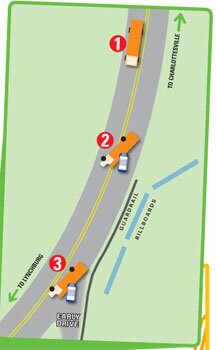
1-The driver struggles to keep the overloaded, speeding truck in the lane
2-The truck tips onto its left side and collides with an oncoming VW Bug
The now-connected vehicles slide to a halt at Early Drive.ALLISON SOMMERS
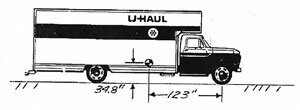
Sixty-four young men, mostly standing, plus their beer and furniture, meant that the vehicle was not only top-heavy but was carrying twice its rated weight.
NTSB

Approximate location of the 64 young men, according to the National Transportation Safety board.
ALLISON SOMMERS
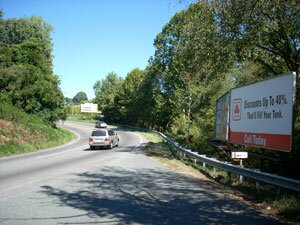
The curve is located a third of a mile from the remains of the old Williams Viaduct, replaced in 1988 by the John Lynch Memorial Bridge.
PHOTO BY HAWES SPENCER
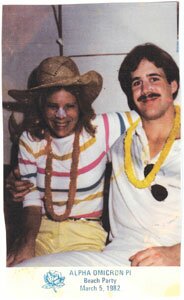
Tom Stumm at a sorority party in the spring before the accident.
PHOTO COURTESY STUMM FAMILY
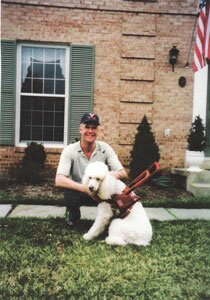
Stumm today with his new service dog, a poodle named Tony.
PHOTO COURTESY STUMM FAMILY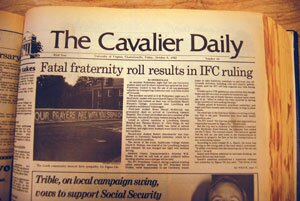
Until the Virginia Tech massacre, this Beta Bridge message stayed up the longest.
CAVALIER DAILY

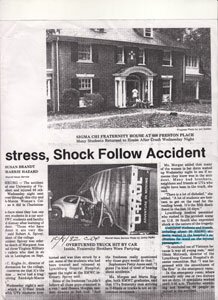
Pushing aside news of the infamous Tylenol poisonings, the story– and the iconic photos by the Lynchburg News' Jimmy Ripley– went nationwide.
LYNCHBURG NEWS, DAILY
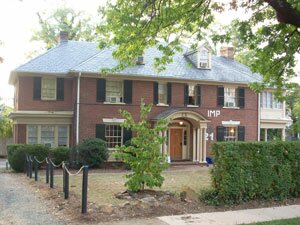
Sigma Chi is still located just off Grady Avenue at 608 Preston Place.
PHOTO BY HAWES SPENCER
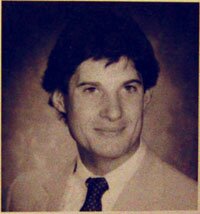
Driver Dave Holmes was "without a doubt the most responsible member of our house," according to then-Sigma Chi president Tom Cricchi.
Corks & Curls
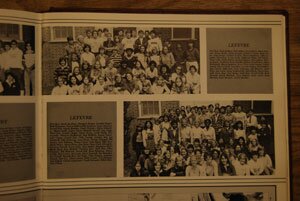
Brian McKittrick was a first-year living in Lefevre
1982 CORKS AND CURLS YEARBOOK PHOTO
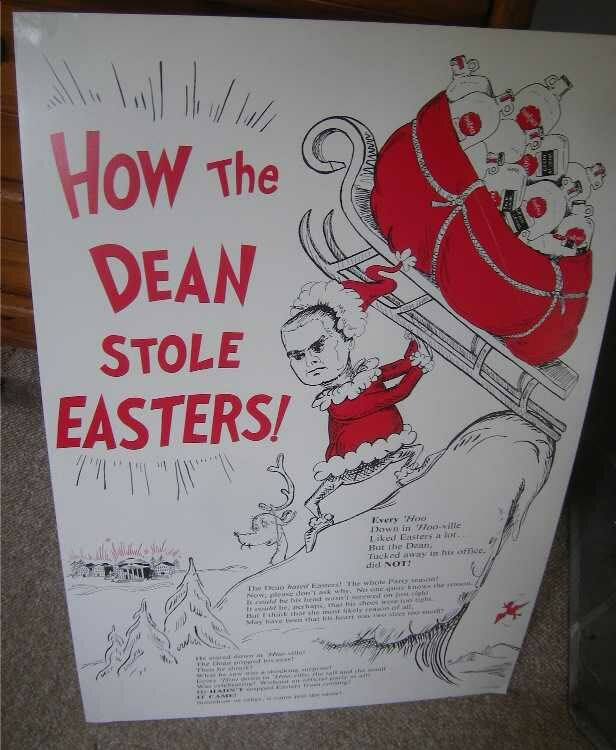
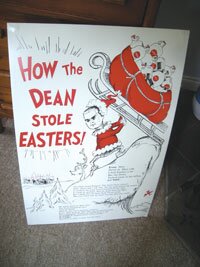 "It wasn't Woodstock, but it was the next best thing," historian Coy Barefoot wrote of the annual Easters celebration. However, the mud and booze didn't amuse the dean of students, who– lampooned here on a poster– announced Easters' termination one month after the Sigma Chi wreck.
"It wasn't Woodstock, but it was the next best thing," historian Coy Barefoot wrote of the annual Easters celebration. However, the mud and booze didn't amuse the dean of students, who– lampooned here on a poster– announced Easters' termination one month after the Sigma Chi wreck.
CORKS AND CURLS; "C. TAYLOR POSTERS"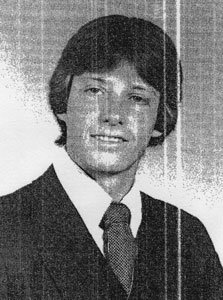
Christopher Meigs was a first-year living in Lyons.
1982 CORKS AND CURLS YEARBOOK PHOTO#